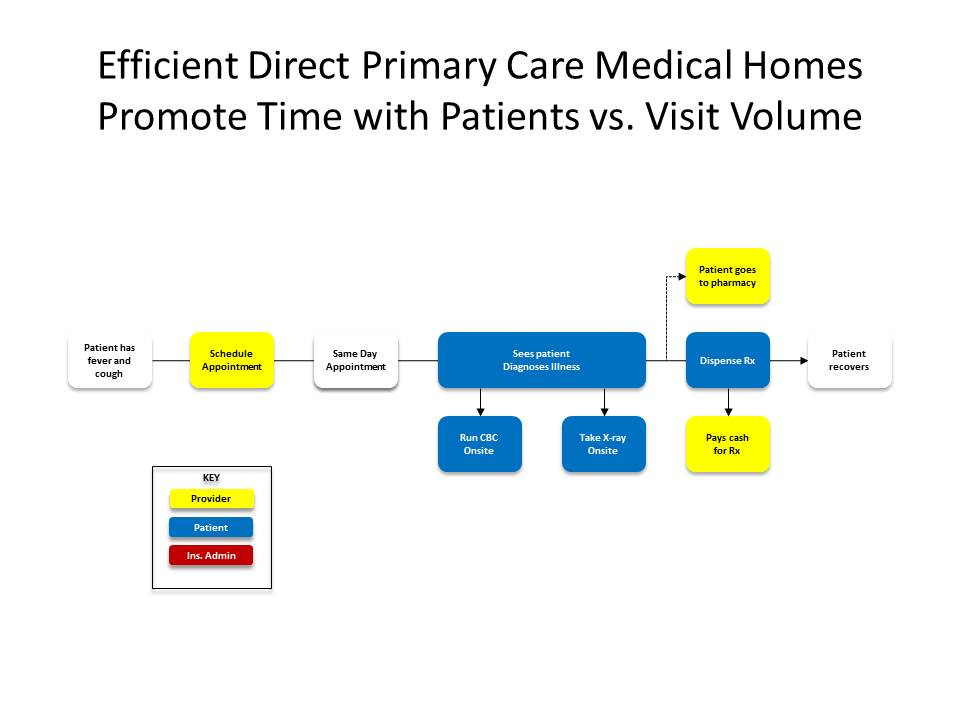Direct Primary Care Explained
 Direct Primary Care (DPC for short) is primary care offered directly by primary care physicians (pediatricians, internists, family physicians) toconsumers without the need of insurance. The model completely eliminates financial burdens physicians deal with when interacting with insurance carriers. Insurance co-pays, deductibles, co-insurance, billing and coding fees, collection fees, account receivables, and low reimbursement are just some of the financial burdens that are eliminated as a result of implementing the model. The model is overall very beneficial to both patients and physicians.
Direct Primary Care (DPC for short) is primary care offered directly by primary care physicians (pediatricians, internists, family physicians) toconsumers without the need of insurance. The model completely eliminates financial burdens physicians deal with when interacting with insurance carriers. Insurance co-pays, deductibles, co-insurance, billing and coding fees, collection fees, account receivables, and low reimbursement are just some of the financial burdens that are eliminated as a result of implementing the model. The model is overall very beneficial to both patients and physicians.
Direct Primary Care Benefits
Physician Benefits
Today’s primary care physician (pediatrician, internist, family practitioner) is facing multiple challenges. Decreasing reimbursement from insurance companies and Medicare, increasing regulations, excessive paperwork, and rising overhead expenses (malpractice insurance, billing, coding, collections, EMR / EHR systems) are challenges that are threatening the doctor-patient relationship. Direct primary care physician benefits include:
- Paid on a per member per month basis
- Removes all the expenses for coding and billing
- Eliminates account receivables (AR), collections, and speeds up the revenue cycle

- Reduced paperwork
- No interference from insurance companies
- Continuous cash flow (revenue stream)
Patient Benefits
In today’s society, more than 30 million Americans are considered to be uninsured or underinsured. High cost and largely discriminatory policies of health insurance companies have prevented these individuals from getting access to medical care. Direct primary care takes away the need for high cost/discriminatory health plans and gives patients direct access to the medical care that they need. Specific patient benefits are:
- Full access to medical care for all Americans and residents
- Protects the “Doctor-patient relationship”
- No barriers to care – no being told by a third-party (insurance company) you can not have certain treatments or procedures
- More time spent with your physician – unhurried appointments
- 24/7 phone, fax, and e-mail access
- No co-pays, no deductibles, no co-insurance
- No limit on visits
- No prior authorizations required
Financial Benefits
 Physicians and medical groups today are facing many financial burdens. These include low reimbursement from insurance companies, Medicare and Medicaid, denial of claims, downcoding of claims, high amounts of account receivables (AR), and high billing and coding fees. These financial woes are common throughout the current Fee-For-Service (FFS) system and are causing severe harm to physicians and medical groups’ bottom lines. These woes will only continue to get worse as insurance companies try to protect their shareholder/ corporate profits.
Physicians and medical groups today are facing many financial burdens. These include low reimbursement from insurance companies, Medicare and Medicaid, denial of claims, downcoding of claims, high amounts of account receivables (AR), and high billing and coding fees. These financial woes are common throughout the current Fee-For-Service (FFS) system and are causing severe harm to physicians and medical groups’ bottom lines. These woes will only continue to get worse as insurance companies try to protect their shareholder/ corporate profits.
The direct primary care model is the best antidote for these financial woes. Direct primary care models specifically pay physicians on a per patient per month basis (provides higher revenue per month), 100% of patient payment goes directly to the physician (0% goes to the pockets of insurance company executives), eliminates contracts with insurance companies, eliminates billing and coding (eliminates all expenses associated with billing and coding), and eliminates account receivables (no more debt produced by patients and slow paying insurance companies). If you like what you hear, consider switching and make sure to check out Medical Access USA’s direct primary care model.
Legal Issues
Is direct primary care, in general, legal under the Affordable Care Act (aka ObamaCare) ? The answer……..is yes! Section 10104 of P.L. 111-148 (Patient Protection and Affordable Care Act) states “The Secretary of Health and Human Services shall permit a qualified health plan to provide coverage through a qualified DPC medical home plan that meets criteria established by the Secretary, so long as the qualified health plan meets all requirements that are otherwise applicable and the services covered by the medical home plan are coordinated with the entity offering the qualified health plan.”
(Patient Protection and Affordable Care Act) states “The Secretary of Health and Human Services shall permit a qualified health plan to provide coverage through a qualified DPC medical home plan that meets criteria established by the Secretary, so long as the qualified health plan meets all requirements that are otherwise applicable and the services covered by the medical home plan are coordinated with the entity offering the qualified health plan.”
As most people know, the success of direct primary care practices is thanks to not having to deal with insurance companies. Under section 1555 of the Affordable Care Act, you can legally drop insurance and you will not be penalized for it. Section 1555 states “No individual, company, business, nonprofit shall be required to participate in any health insurance program created under this Act (or any amendments made by this Act), or in any insurance program expanded by this Act (or any such amendments), and there shall be no penalty or fine imposed upon any such issuer for choosing not to participate in such programs.” Stay tuned for more information from BHM Healthcare Solutions.
Photo credit: commons.wikimedia.org
Matthew D. Taber, M.S. is Chief Operating Officer of Medical Access USA (www.medicalaccessusa.com), a company which offers full access to medical care to patients and 100 percent reimbursement to primary care physicians through direct primary care models.






